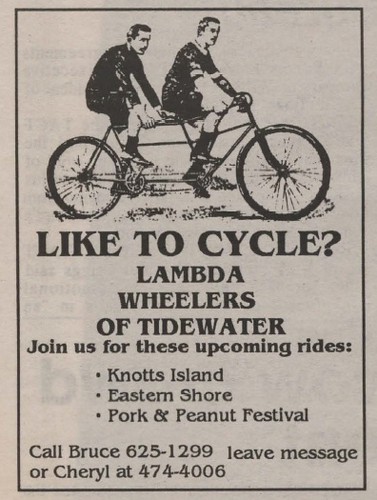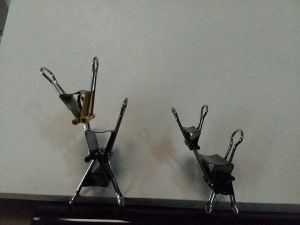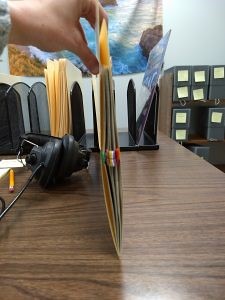By Mel Frizzell, Special Collections Assistant
This is a continuation of my blog posts referencing Our Own Community Press, a Virginia LGBTQ+ community newspaper which ran from 1976 to 1998.
With the Fall semester starting, I thought about the timeless “What I did on my summer vacation” essay that so many of us were asked to write upon returning to school. With so many summer activities and vacations cancelled this summer due to the current pandemic, I thought I would highlight what LGBT folks did for summer vacations in the 1990s. While many LGBT folks did the same things as everyone else – such as visiting the beach, going on cruises, or enjoying theme parks – there are LGBT specific things that are mentioned or advertised in Our Own Community Press so I thought I would highlight some of these.
One did not need to travel far to find summer activities such as sports, recreational clubs, conferences and gatherings, festivals, or other events catering to the LGBT community. Local LGBT sports teams, clubs, and activities included the Lambda Wheelers, an LGBT bicycling group; the Mid-Atlantic Amateur Softball Association; volleyball tournaments at Stockley Gardens and Northside Park in Norfolk; and the Mid-Atlantic Bowling League. Other recreational activities included canoeing, hiking, rollerblading, women’s golf, and even skydiving.
Local summer benefits included pool parties sponsored by the Tidewater AIDS Crisis Taskforce (TACT) and the AIDSCARE Sunset Sprint Music Festival held at Ocean View Beach Park in June 1997. Some LGBT folks attended the biannual Stockley Gardens Art Festival held each May.
Local cruises on the Elizabeth River were popular. The Mandamus Society, an LGBT social group, held an annual cruise on the Carrie-B during the 90s. At least one year, there was an LGBT cruise on the Spirit of Norfolk too. While “Gay Days” at Busch Gardens had not yet become a thing, the first “Gay Days” at King’s Dominion was held in July 1997. “Gay Days” at Disney World in Florida began in the summer of 1991.
Beach vacations were also quite popular. Virginia Beach had its very own “Gay Beach Resort.” The Coral Sand Motel located on Pacific Avenue catered to LGBT clientele. The Outer Banks provided nearby beach getaways for LGBT folks. Rehoboth Beach in Delaware was also a popular choice. The Mandamus Society and Dignity, an LGBT Catholic group, both planned trips there in the 1990s. Our Own contains advertisements for Rehoboth Beach Resorts.
LGBT conferences and gatherings ranged from the serious to the fun. Many catered to diverse populations within the LGBT community. Serious conferences included the annual Lesbian and Gay Health Conference and AIDS Forum; the Southeast Lesbian / Gay Conference in July 1991; the International Lesbian & Gay Conference in Acapulco in 1991; and a Lesbian Writer’s conference in 1992.
Fun favorites included many women’s festivals and gatherings such as the Richmond Women’s Festival in 1990; the Roanoke Valley Women’s Festival in 1991, an annual East Coast Lesbian Festival; and WomenFest in Key West, FL in 1997. Regular women’s festivals were held at Twin Oaks campground in Luisa, Virginia and the INTOUCH women’s campground in Kent’s Store, Virginia. Music festivals were especially popular among Lesbians. These festivals included the Northeast Women’s Musical Retreat; the annual Virginia Women’s Music Festival held at INTOUCH; and the annual Rhythm Fest Women’s Music, Art, and Politics Festival held at Lookout Mountain in Georgia. Some men held camping gatherings too. These include the annual Gay Spirit Visions Conference in Highlands, NC and a men’s gathering held at Twin Oaks in 1993. Women’s and men’s gatherings sometimes highlighted LGBT-affirming alternative spiritual beliefs including New Age, Pagan, and Earth-based spirituality.
Film festivals were also popular among LGBT folks. Among these were the North Carolina Gay and Lesbian Film Festival the summer of 1997 and Outfest, an annual gay and lesbian film festival held in Los Angeles.
Many conferences highlighted the diversity among LGBT folks – the Golden Threads Lesbian Celebration for Lesbians over age 50 in 1990; the National Gay Young Adults Conference also in 1990; a 1990 gathering of North and South American Native American LGBT folks; a 1996 conference and AIDS institute for gay men of color; and an annual “Women Celebrating Our Diversity” Gathering at Twin Oaks Campground. Gay geeks weren’t left out as the Gaylaxicon science fiction convention, which was founded in 1988, continued throughout the 1990s and beyond.
Other big events of the 1990s included the Gay Games, an Olympic style event for LGBT athletes. The Gay Games started in 1982 and continues to this day. In the 1990s, the event was held in 1990, 1994, and 1998. Many LGBT folks also attended the 1996 International Summer Olympics in Atlanta, GA. The Atlantic States Gay Rodeo is mentioned in Our Own articles for 1996 and 1997. Many LGBT folks attended the GALA performing arts festival held in Tampa, FL in 1996. Maya Angelou was a keynote speaker at the event.
The 1990s were a great time for LGBT vacation packages. In the 1990s the travel industry took note of a perceived “disposable income” within the LGBT community. The idea is that many LGBT professional couples have extra income that isn’t going toward raising children that they can spend on leisure instead. While this myth persists even today, and there are many affluent people in the LGBT community, there are also many LGBT folks who aren’t especially wealthy or have dependents – LGBT parents (notably Lesbian mothers), LGBT folks from low income communities, and LGBT folks who have met with job discrimination. During the 1990s the LGBT travel industry flourished. Companies such as Toto Tours and Alyson Adventures offered tours, cruises, and destinations specifically for LGBT travelers. Sometimes there were separate women’s and men’s vacations, and other times the events were mixed. Local travel agencies such as Moore Travel (Norfolk), UNIGLOBE ITA Travel (Norfolk), and Four Seasons Travel (Williamsburg) arranged LGBT vacation packages. Bed and breakfasts and private resorts catering to LGBT folks offered options for those looking for smaller, low-key vacations.
LGBT travel magazines and guides promoted the LGBT travel industry. Such publications included magazines like Our World and Out and About; global guides such as Damron’s many guides, Ferrari’s Places of Interest: Worldwide Gay & Lesbian Guide, and Women Going Places 1993/94: A Women’s Complete Guide to International Travel; and city specific guides like Betty & Pansy’s Severe Queer Review of San Francisco and Washington, D.C.: An Alternative Guide For Those Who Don’t Necessarily Travel the Straight and Narrow.
So, while most of us are hoping that 2021 will be a better time than 2020 for joining in recreational activities or going on vacations, we can always look back at what folks did for fun in the 1990s. Perhaps looking through the articles, advertisements, and event listings in Our Own will provide you with nostalgia for the days when we could go out without masks and social distancing. Better yet, it might give you an idea for something to do when this pandemic is over.
Archived issues of Our Own Community Press are available digitally at: https://dc.lib.odu.edu/digital/collection/ourown











